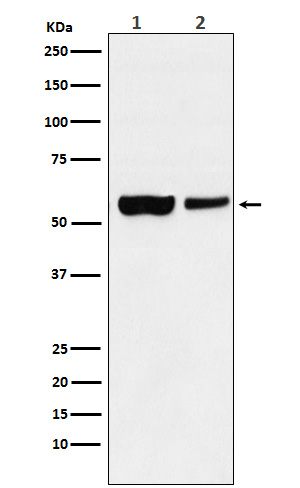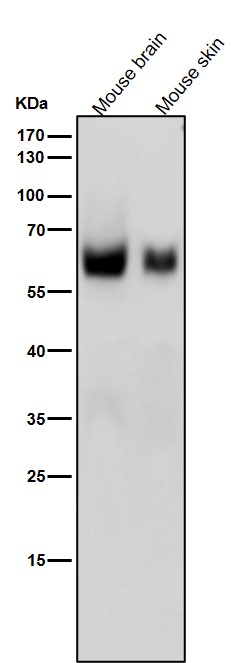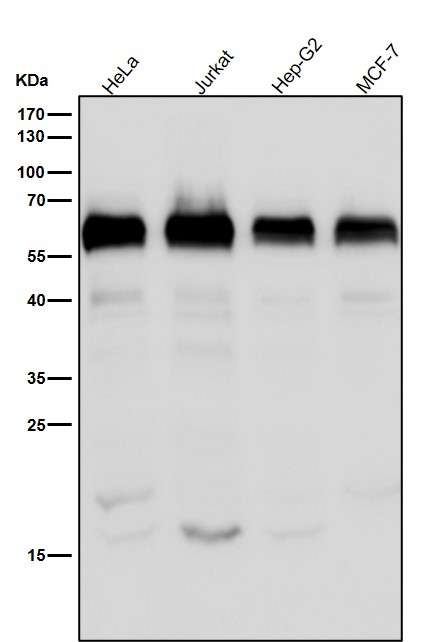


| WB | 1/1000-1/2000 | Human,Mouse,Rat |
| IF | 1/20-1/50 | Human,Mouse,Rat |
| IHC | 咨询技术 | Human,Mouse,Rat |
| ICC | 1/50-1/200 | Human,Mouse,Rat |
| FCM | 咨询技术 | Human,Mouse,Rat |
| Elisa | 咨询技术 | Human,Mouse,Rat |
| Aliases | Ubiquitin carboxyl terminal hydrolase 22; Usp22; USP3L;;USP22 |
| WB Predicted band size | 60 kDa |
| Host/Isotype | Rabbit IgG |
| Antibody Type | Primary antibody |
| Storage | Store at 4°C short term. Aliquot and store at -20°C long term. Avoid freeze/thaw cycles. |
| Species Reactivity | Human,Mouse,Rat |
| Immunogen | A synthesized peptide derived from human USP22 |
| Formulation | Purified antibody in PBS with 0.05% sodium azide,0.05% BSA and 50% glycerol. |
+ +
以下是关于USP22抗体的3篇代表性文献及其摘要概括:
---
1. **文献名称**:*USP22 regulates oncogenic signaling in cancer stem cells and tumorigenesis*
**作者**:Zhang XY, et al. (2008)
**摘要**:该研究开发并验证了USP22特异性抗体,发现USP22在多种癌症组织中高表达,与患者预后不良相关。通过抗体介导的染色和功能实验,证明USP22通过调控β-catenin等信号通路促进肿瘤干细胞自我更新和转移。
2. **文献名称**:*USP22 Deubiquitinates the Tip60 Complex to Promote Transcriptional Activation*
**作者**:Lang G, et al. (2012)
**摘要**:研究利用USP22抗体进行免疫共沉淀(Co-IP)和染色质免疫沉淀(ChIP),发现USP22通过去泛素化Tip60复合体中的组蛋白H2B,增强靶基因转录活性,揭示了其在表观遗传调控中的关键作用。
3. **文献名称**:*USP22 mediates chemoresistance through stabilization of HIF-1α in cancer*
**作者**:Lin Z, et al. (2015)
**摘要**:通过Western blot和免疫组化(IHC)实验,该研究证实USP22抗体可检测其在缺氧条件下表达上调,并稳定HIF-1α蛋白,促进肿瘤细胞对化疗药物的抵抗,为靶向USP22克服耐药性提供依据。
---
以上文献均通过USP22抗体进行蛋白定位、功能验证或临床相关性分析,涵盖癌症机制、表观遗传及治疗抵抗等领域。如需具体文献来源,可进一步检索PubMed或期刊数据库。
The USP22 (ubiquitin-specific protease 22) antibody is a research tool used to study the function and expression of USP22. a deubiquitinating enzyme (DUB) belonging to the ubiquitin-specific protease family. USP22 plays a critical role in regulating protein stability by removing ubiquitin chains from target proteins, thereby preventing their degradation by the proteasome. It is involved in diverse cellular processes, including transcriptional regulation, cell cycle progression, and epigenetic modulation. Notably, USP22 is a component of the human transcription elongation regulator complex (hPAF complex), linking it to histone modification and gene expression control.
Research highlights USP22’s dual role in cancer biology. It is implicated in tumor progression and metastasis, often overexpressed in malignancies like colorectal, breast, and liver cancers, where it correlates with poor prognosis. USP22 is also recognized as a member of the "cancer stem cell signature," suggesting its role in maintaining stem-like properties in tumor cells. Conversely, USP22 may act as a tumor suppressor in certain contexts, emphasizing its context-dependent functions.
USP22 antibodies are widely used in techniques such as Western blotting (WB), immunohistochemistry (IHC), and immunofluorescence (IF) to detect USP22 expression levels and localization in tissues or cell lines. These studies aim to elucidate USP22’s mechanistic contributions to diseases and its potential as a therapeutic target or biomarker. Ongoing research explores targeting USP22 with small-molecule inhibitors to disrupt its oncogenic activities, underscoring its clinical relevance.
×